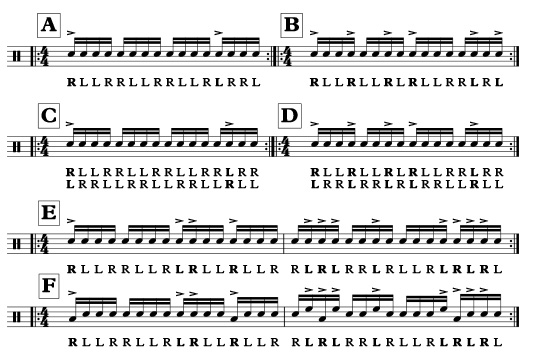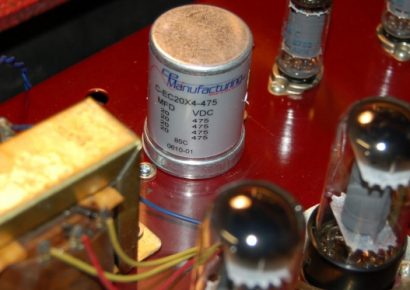When I started learning how to use accents on the drums, I was taught primarily using single strokes and eventually paradiddles. This is still the recommended way to approach accents, particularly for younger students. The idea is that the rudiments give a solid platform to base accented ideas on that can then move onto the drum set. Rudiments are essentially small, repeated patterns that are easier to memorize and therefore easier to start experimenting with across the drums – moving the accents onto toms and cymbals.
A little, but notable challenge can occur if you only use the rudiments to approach accent playing, and that is that the drummer can often sound a little too clinical and rigid. A paradiddle for example, has a certain sound on the drums and after a while, there’s not that much creativity involved and it’ll always sound like you’re using a paradiddle.
So to get around this problem and to get my mind out of the rudiments a bit more, I was taught a great concept that promotes freedom, creativity, change of the leading hand and ultimately, improvisation. The simple rule is this:
An accent (>) followed by any number of double strokes until the next accent
If we look at figure A, we can see a simple accent pattern over 16th notes in 4/4 time – one accent at the start of the bar followed by double strokes until another accent on beat 4. Note that to keep things moving, you always move to the opposite hand whenever another accent occurs or when double strokes begin. You also don’t need to always do a full double stroke. If you have two accents next to each other or one note apart from each other, there won’t be room but you’ll still attempt doubles and no more than double strokes as playing anything more than two strokes in a row can be harder to maintain at higher tempos.
One thing that you also may notice is that the double strokes aren’t always played on the beat – in fact quite the opposite. Inward or inverted double strokes are more common with this concept – RLLR RLLR. This can take some time to get comfortable with but the advantage of this is that the second stroke of every double is now on a strong beat, which can produce a cleaner roll. Win!
Figure B shows the concept with additional accents, making for a slightly more complicated phrase. It’s important to remember that the accents are completely improvised with their placement. Since it’s not a strict paradiddle or rudiment, we’re not restricted as to where the accents can go. Simply place wherever you like and fill in the gaps using the formula. Accent, then doubles until the next accent and repeat.
Another challenge is when the pattern ends on the same hand, it started on making the whole pattern opposite to itself. This is actually a very cool thing however. Now your pattern can be played with different leading hands leading to more possibilities for sounds (FIG C).
Figure D shows the same accent pattern from Figure B but with one accent missing from the last note. As you’ll see, this one little change results in the opposite sticking on the repeat. Therefore, when you design your accent pattern, make sure that you’re aware that you may have to do this. Double or multiple accents are also very possible as you can see in figure E but crucially, the formula remains the same.
At this point you may query the fact that each of these patterns, even with the formula is still ‘designed’ and structured, which theoretically is no different to a paradiddle. The difference here and the amazing thing that happens over time (through repetition of many examples) is the brain is able to adapt and use the formula at random resulting in the ability to improvise accents. If you think about it, it’s not that difficult. We’re able to make split second decisions during drum solos aren’t we? Your phrasing will be more spontaneous and more natural to the ear and unlike the paradiddle; the foundation pattern is constantly changing. I suppose, yes, even this formula can have its own sound but at least it’s changing up all the time for a more natural approach.

